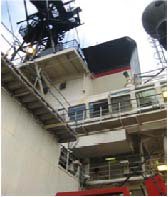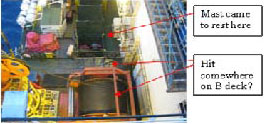High potential dropped object near-miss: antenna fell to deck
A member has reported an incident in which a large piece of equipment fell over 20 metres to the deck. A top section of an antenna, approximately 4m in length and weighing around 3.5 kg, fell 24m to the main deck. No one was in the vicinity at the time, however, this incident had the potential to result in a fatality.
While the vessel was in transit a bang was heard above the bridge and immediately after, a long white pole was seen falling past the bridge window. The pole came to rest on A deck, after first hitting B deck (3.5m above A deck). On inspection it was found that the pole was the top section of the non-directional beacon (NDB) whip antenna.
It was discovered the threaded connection on the end of the section that fell was undamaged and was not corroded. The connection consisted of a threaded inner which screwed on to the lower section of the antenna; this was then retained by 2 grub screws. These were found to have come loose.
There was no evidence of any mitigation against the effects of vibration on these grub screws, such as anti vibration washers or ‘loctite’. Investigation suggested that vibration over the period since the antenna was last removed (approx 2½ years) had caused the grub screws to come loose and the top section of the antenna was able to unscrew against gravity.


Following investigation, the following lessons and conclusions were drawn from the incident:
- The location of the antenna connection was not readily accessible and, as such, limited ‘routine’ inspection had been undertaken;
- The potential for the mast to vibrate loose was not recognised during installation, resulting in a failure to mitigate the effects of vibration;
- Securing of masts and antennas should be checked with additional and/or secondary securing measures implemented where required.
Safety Event
Published: 14 July 2010
Download: IMCA SF 04/10
IMCA Safety Flashes
Submit a Report
IMCA Safety Flashes summarise key safety matters and incidents, allowing lessons to be more easily learnt for the benefit of all. The effectiveness of the IMCA Safety Flash system depends on Members sharing information and so avoiding repeat incidents. Please consider adding safetyreports@imca-int.com to your internal distribution list for safety alerts or manually submitting information on incidents you consider may be relevant. All information is anonymised or sanitised, as appropriate.
IMCA’s store terms and conditions (https://www.imca-int.com/legal-notices/terms/) apply to all downloads from IMCA’s website, including this document.
IMCA makes every effort to ensure the accuracy and reliability of the data contained in the documents it publishes, but IMCA shall not be liable for any guidance and/or recommendation and/or statement herein contained. The information contained in this document does not fulfil or replace any individual’s or Member's legal, regulatory or other duties or obligations in respect of their operations. Individuals and Members remain solely responsible for the safe, lawful and proper conduct of their operations.
